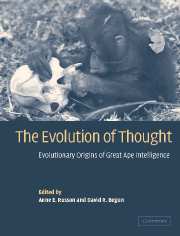Book contents
- Frontmatter
- Contents
- List of Contributors
- Preface
- 1 Evolutionary reconstructions of great ape intelligence
- 2 Enhanced cognitive capacity as a contingent fact of hominid phylogeny
- PART I COGNITION IN LIVING GREAT APES
- Introduction
- 3 The manual skills and cognition that lie behind hominid tool use
- 4 The cognitive complexity of social organization and socialization in wild baboons and chimpanzees: guided participation, socializing interactions, and event representation
- 5 Gestural communication in the great apes
- 6 Great ape cognitive systems
- PART II MODERN GREAT APE ADAPTATION
- PART III FOSSIL GREAT APE ADAPTATIONS
- Part IV INTEGRATION
- Author index
- Species index
- Subject index
5 - Gestural communication in the great apes
Published online by Cambridge University Press: 20 August 2009
- Frontmatter
- Contents
- List of Contributors
- Preface
- 1 Evolutionary reconstructions of great ape intelligence
- 2 Enhanced cognitive capacity as a contingent fact of hominid phylogeny
- PART I COGNITION IN LIVING GREAT APES
- Introduction
- 3 The manual skills and cognition that lie behind hominid tool use
- 4 The cognitive complexity of social organization and socialization in wild baboons and chimpanzees: guided participation, socializing interactions, and event representation
- 5 Gestural communication in the great apes
- 6 Great ape cognitive systems
- PART II MODERN GREAT APE ADAPTATION
- PART III FOSSIL GREAT APE ADAPTATIONS
- Part IV INTEGRATION
- Author index
- Species index
- Subject index
Summary
INTRODUCTION
This chapter will focus on aspects of great ape gestural communication that have implications for cognition and human language. From an evolutionary perspective, gestures may provide an important link across primate species in communicative systems. As a researcher interested in the development of language in human infants, and its precursors, I will stress similar developments, or their absence, in great apes. These developments will include communicative gestures, symbolic gestures, sign acquisition, and sign combinations.
Gesture has a very broad usage; here it will be restricted to movements of the hand, arm, head, and body with communicative functions. Postural and tactile gestures, as well as facial expressions, although often communicative, are not a focus because their implications for language are unclear. It must be kept in mind, however, that visual communication is a complex, redundant system in which these various components are usually combined (Marler 1965).
I will begin with a brief review of communicative gestures according to their functions and then focus on specific gestures involved in exchange, requests involving cognizance of agency, and pointing, as well as on the degree to which great ape gestures are intentional and inventive. These are the kinds of gestures and their characteristics that are related to the development of language in human infants. I then discuss the extent to which apes display symbolic gestures, both in captivity and in the wild, because such gestures in human infants emerge during the transition to language.
- Type
- Chapter
- Information
- The Evolution of ThoughtEvolutionary Origins of Great Ape Intelligence, pp. 61 - 75Publisher: Cambridge University PressPrint publication year: 2004
- 6
- Cited by



